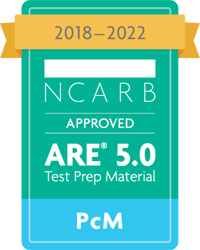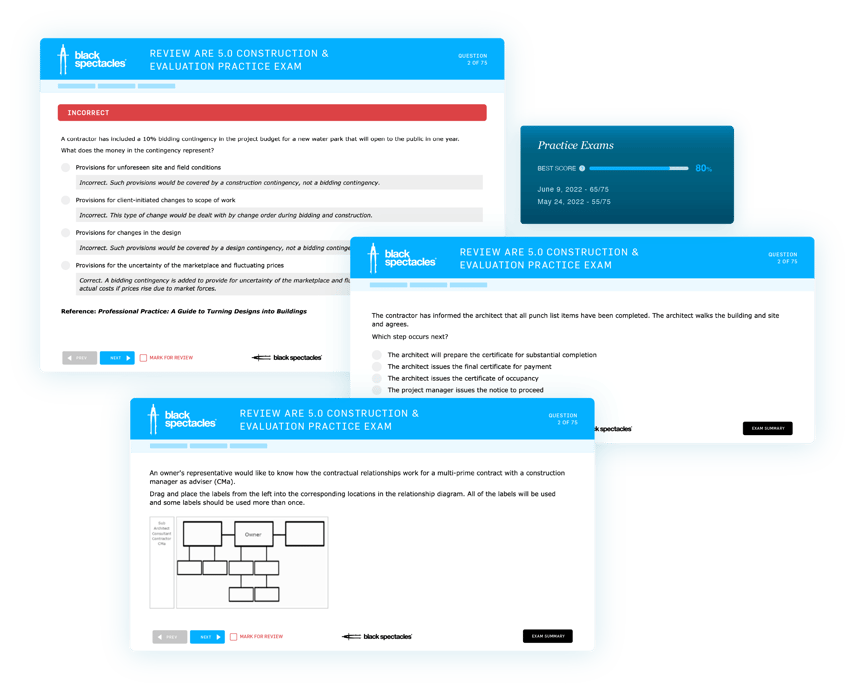Section 1: Business Operations
Business operations sets the stage for managing a practice. It’s all about making decisions regarding who should be hired by your firm, and how you should staff projects. The classic "Which architect should be the project manager for this project?" ARE® question is answered in this section. The standard of care and ethical considerations are also a central focus of the business operations section. While not every question will directly relate to these concepts, they should always be in your mind when you’re assessing a question on this division of the ARE®.
4 content areas to prepare for business operations:
1. Assess resources within the practice
Hiring and staffing projects may seem like a task that’s not applicable to you now—but the exam tests your ability to independently practice architecture, which could involve these tasks in your future. In this objective, you’ll learn about best practices when assessing and allocating resources to set your firm, and your projects, up for success.
2. Apply the regulations and requirements governing the work environment
Architects often worry about liability when it comes to design defects, but it’s important to comply with all relevant laws when running a business—and this includes employment laws. With a solid understanding of these laws, you’ll be able to set up your firm with a foundational employee manual that will provide clarity for employees, managers, and principals.
3. Apply ethical standards to comply with accepted principles within a given situation
Architects are held to high ethical standards. Like many other professionals, you provide services to the public who are less knowledgable about your area of expertise. As a result, architects always need to act within ethical standards so the public can trust the profession and the buildings you create. In this section, you'll learn about the AIA ethical guidelines and NCARB model rules of conduct, and how these documents can be a guiding light through various ethical decisions.
4. Apply appropriate standard of care within a given situation
Acting within the standard of care is crucial to an architect’s ability to mitigate risk. If architects agree to perfection, either in words, writing, or through their actions, they’re setting themselves up for a potential risky situation. This section will dive into the importance of the wording of the AIA standard of care, and how to ensure that you don’t over promise on your projects.
Section 2: Finances, Risk, & Development of Practice
Finances, risk, & development of practice is all about setting your practice up for financial success. This includes being able to interpret financial documents and make decisions based on them, as well as considering risk when making decisions about a project. When taking on a project, there’s almost always going to be negotiations between you and your client about things like your scope of work, fee, and contractual provisions. You’ll need to be able to have these discussions and consider a win-win negotiating strategy in order to obtain new work—while still protecting your business interests from unnecessary risk or loss of profit.
3 content areas to prepare for finances, risk, & development of practice:
1. Evaluate the financial well-being of the practice
Even the most skilled designer can’t manage a successful practice without a solid understanding of firm financials. You’ll need to understand how to plan for profit, budget resources, and track your progress against these established goals throughout the year. In this section, you'll dive into the different aspects of a business plan, why they're important, and how they impact your office.
2. Identify practice policies and methodologies for risk, legal exposures, and resolutions
Risk is a topic that comes up often amongst architects, and for good reason: understanding how to appropriately mitigate risk is crucial to being able to stay in business. In this section, you’ll learn about the importance of widely-accepted contractual provisions, as well as how dispute resolution can be used to solve an issue during the course of a project.
3. Select and apply practice strategies for a given business situation and policy
To be competitive as an architectural practice, you’ll need to be able to negotiate with your clients on certain terms of your contract. You’ll learn how to understand your clients needs—and how to balance them with your own—in order to come up with a win-win solution when faced with contractual revisions.
Section 3: Practice-Wide Delivery of Services
The first two sections of PcM focus on firm-wide decisions, like hiring, finances, and risk mitigation. Practice-wide delivery of services starts to apply the decisions made at the firm level to individual projects. You’ll learn about how to consider if a project is worth pursuing based on your business plan and the amount of risk it poses, how to respond to RFPs to give your firm the best chance of success at winning new work, and some key AIA contracts that you’ll need to be familiar with.
3 content areas to prepare for practice-wide delivery of services:
1. Analyze and determine response for client services requests
Getting clients to notice your firm through marketing efforts is one thing, but closing the deal and getting hired to design the project is another. We’ll discuss how to position your firm to win RFPs by creating thoughtful responses to your potential client’s requests.
2. Analyze applicability of contract types and delivery methods
Understanding what you’ve contractually agreed to do is a critical part of managing a practice. You can’t prepare fee proposals, manage a project, and be profitable without a solid understanding of contracts first. You’ll learn the provisions in AIA contracts and how internalize them so that they become second nature so you can focus on other key areas.
3. Determine potential risk and/or reward of a project and its impact on the practice
A key aspect of owning a practice is understanding which projects are worth going after—and which are worth passing on. In this section, we'll discuss what can go wrong in this stage of a project, the cost-benefit analysis you should do, and how you can be strategic when taking on new work.
Section 4: Practice Methodologies
There are a number of ways that you can go about organizing your firm to perform work, as well as different methodologies and philosophies that you can employ based on your business situation. Practice methodologies talks about these types of decisions that you need to make about your firm, and how they might impact you.




